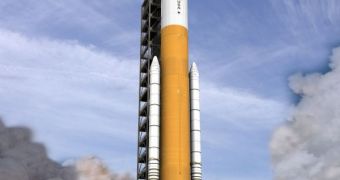Even if theoretically this should not happen, a Senate bill gives NASA precise instructions on how it should construct its next generation of heavy-lift delivery systems.
Experts with various panels and committees in the US Congress have taken a deep interest in the American space agency's future, ever since US President Barack Obama proposed that Project Constellation be canceled.
In the mean time, two new bills have been approved, which basically seek to resurrect the program, only without its name. The Orion spacecraft is a good example of this.
Originally designed so that it could carry four astronauts to the Moon, the Orion Crew Exploration Vehicle was to be stripped down to a basic version under the new Obama plans, SpaceRef reports.
But the two new bills propose that Lockheed Martin, the main contractors, continue work on the capsule as it was supposed to under the initial contract.
What did change in the bills is that Congress agreed not to continue work on the ARES V delivery system, a massive rocket that could ferry 188 tons to low-Earth orbit (LEO), and 71 tons to Trans Lunar Injection (TLI) orbit.
In a report by the House Science and Technology Committee, chaired by Rep. Bart Gordon (D-Tenn), experts give NASA direct indications of how its future heavy-lift vehicle should look like.
“The Committee anticipates that […] the most cost-effective and 'evolvable' design concept [includes] a large center tank structure with attached multiple liquid propulsion engines and, at a minimum, two solid rocket motors composed of at least four segments being attached to the tank structure to form the core, initial stage of the propulsion vehicle,” the document reads.
“The Committee will closely monitor NASA's early planning and design efforts to ensure compliance with the intent of this section,” the authors write further.
Congress appears to be seeking the development and construction of a heavy lift rocket as soon as possible, even if Obama's plans calls for funding to be alloted for researching related technologies.
In other words, the president is looking to develop new boosters, propulsion systems and fuels for such a vehicle, and not creating the vehicle itself.
Through this new report, the Committee is basically making its own proposition of how the American space agency should conduct its affairs.
Considering that its proposal forces NASA to use technologies from the 1970s, rather than looking at new alternatives, may not be such a good thing.

 14 DAY TRIAL //
14 DAY TRIAL //